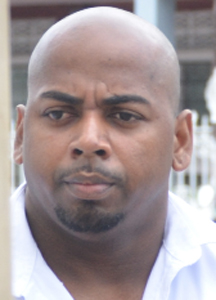Government Pathologist Dr Nehaul Singh who performed a post-mortem examination (PME) on the remains suspected to be that of murdered teen Neesa Gopaul, testified yesterday that the body was missing 50% of its head and that the blunt trauma had been forcefully inflicted.
He said there was no brain in the body and that the injuries were inflicted while the person was still alive.
Bibi Sharima-Gopaul, Neesa’s mother, and Jarvis Small are on trial for her murder before Justice Navindra Singh and a 12-member jury. They are accused of killing the 16-year-old between September 24, 2010, and October 2, 2010, at Madewini, Linden-Soesdyke Highway. The teen’s body had been stuffed into a suitcase, which was anchored in a creek at the Emerald Tower Resort with several dumbbells.

Dr Singh in his testimony detailed that after examining the body, he found that the hymen was ruptured, observing that it was at the “10 ‘o’ clock position.” He said this was indicative of the person being sexually active and that the rupture was an old one.
The PME report was tendered in evidence and the doctor detailed the external examination highlighting that the body was in an advanced state of decomposition with total skin slippage; it was flaccid and no marks of violence were seen from the neck to the toes.
The court heard that hair was missing from the head, and so was the top of the head and scalp.
He said that both parietal bones were missing, as well as part of the left occipital bone, the entire left temporal bone, maxillary and manbular bones.

The pathologist said also that all the teeth were missing and there appeared to be a small fracture on the left occipital bone with subperiortal haemorrhages. He said a specimen was taken for histology and there was also haemorrhage to the right temporo occipital sutures.
The court also heard from the report that there was a laceration of 1x3cm to the scalp behind the ear, as well as a 4x1cm laceration just above the left ear. The doctor said that there appeared to be subscalpular haemorrhage under all these injuries.
Dr Singh noted also that no urine or bile was available for testing and that no swabs were taken from the vagina or anus. He said a small quantity of blood was taken from the chest cavity and no fracture or haemorrhage was seen at the neck structure.
The doctor explained that about 50% of the head was missing from the body, including the brain and that whatever was still there, had been so badly decomposed, that the body could not be identified by facial features.
He said that a rib, along with specimens from the lung and liver were handed over to Superintendent Stephen Greaves of the Police Forensic Laboratory for DNA testing.

Sharima-Gopaul wept as the details of the post-mortem report were related, while her co-accused sat beside her in the prisoners’ dock with an expressionless countenance.
The woman appeared distressed and was observed bowing her head in her hands which rested on her lap; raising occasionally to wipe her eyes or drink water from a bottle she had beside her.
There was complete silence in the courtroom; everyone listened intently as the doctor presented his findings and was cross-examined by the defence for the greater part of yesterday’s hearing.
Responding to questions from State Prosecutor Diana Kaulesar, Dr Singh explained that a flaccid body is one which is not stiff; meaning that it had gone through rigor mortis and came out of that process as well.
The court heard that having tested specimens from the body, there was the presence of vital tissue reaction which indicated that the person was alive when the injuries were inflicted. He said too that the blunt trauma from which the person died, were injuries caused by a dull, as opposed to a sharp object/instrument.
Singh had stated that the blunt trauma had been delivered with a “great amount of force.” Asked what caused him to form that opinion, the pathologist said because of the fractures sustained to bone, “it must have been delivered with a great amount of force.”
Under cross-examination by attorney Glenn Hanoman, one of Small’s four lawyers, the witness stated that two premolars were found. Singh agreed that he had stated in his PME report that the body had no teeth.
However, he said that part of his purpose on the witness stand was to make clarifications in his report. He then said that two premolars were found adding that “we all make mistakes and I don’t have a proofreader.”
Singh told Hanoman that he understands the importance of accurately compiling his report, but said it was an oversight and apologized. However, he contended that it did not substantially change the content of his report nor alter his findings of the cause of death.
On the question of by whom and what means was the body identified to him, Singh said that Mohamed Kayum who identified the body as being that of his granddaughter, indicated to him that there was a deformity to a toe.
The pathologist however said that he found nothing deformed about any toe and that they had all looked “normal” to him.
Having stated that there was the presence of a little food in the stomach, Singh agreed with a suggestion from counsel that it would have been useful to conduct toxicology testing in a bid to find out if poisoning “was a factor in this case.”
Asked whether he had done testing for the presence of alcohol, the doctor responded in the negative; adding also that there was very little blood in the body.
Responding to a question from Hanoman, the doctor said it was possible for a person to have sustained some of the injuries detailed through falling from a verandah onto a tree stump. But he pointed out that the balcony would have to be at a certain height and the person would have to be falling at a certain amount of miles per hour and would have to land in a certain way, before such injuries could be sustained.
Admitting under cross-examination that he did not swab the inside of the vagina, Singh said that he saw such an exercise as useless since he would have been looking for sperm and bacteria specimens.
He explained to the court that these are living organisms which would have all died within eight hours of the person having been dead, since the body had been submerged in water. The pathologist explained that from his examination, the person had been dead for about 36-48 hours.
Asked whether he had ever examined a body which was killed by a jaguar, Singh told Hanoman no. Counsel then said he knew that jaguars usually crush the greater part of their prey’s skull.
Hanoman was about to make a point about a cow and a jaguar when the prosecutor objected, questioning the relevance of the question and the expertise he would claim to have about how such animals attack their prey.
Justice Singh prohibited the question.
The doctor disagreed with Hanoman’s suggestion that his findings were based on speculation.
Meanwhile, under cross-examination by Sharima-Gopaul’s attorney George Thomas, Singh agreed that he was unable to determine with any certainty what type of object may have caused the blunt trauma; only that it was not sharp and had to have been heavy.
Greaves, who is stationed at the Criminal Investigation Department and attached to the Police Forensic laboratory also testified yesterday.
He recalled collecting a rib and specimens from the lung and liver from Dr Singh after the PME was done. He testified also that he swabbed Sharima-Gopaul’s inner cheek after she signed a consent form for samples for DNA testing to be collected to confirm whether the body found was her daughter’s.
According to the superintendent, samples were also collected from Kayum and another of his daughters, as well as a toothbrush belonging to Neesa’s little sister Merriam.
The court heard from this witness that he later travelled to the Barbados Forensic Sciences Centre where the specimens were handed over.
Under cross-examination, by Hanoman, Greaves said he never collected the samples from Barbados and would not know what happened to them; but answered in the affirmative as to whether he had collected the results.
At this point of the cross-examination, the case was adjourned to this morning when Greaves will continue to be cross-examined.




